Why do you get bumps and pimples on your back?
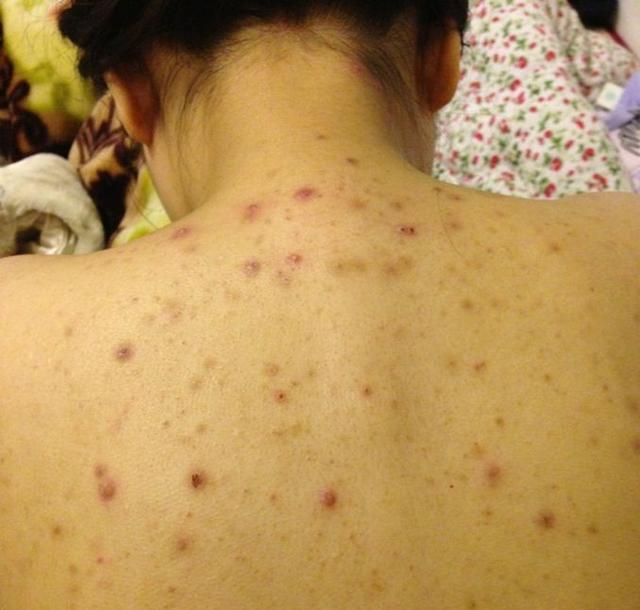
With the progress of the times, the improvement of the material standard of living, people's love of beauty is also more and more intense. Clinically we often see a lot of patients because of small bumps on the back, acne and medical treatment, so what is the cause of this situation?
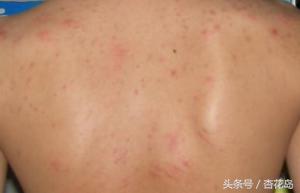
The two most common skin conditions that cause bumps and pimples on the back are acne and folliculitis. Acne is mostly an endocrine disorder caused by stress, insufficient sleep, late nights, and eating greasy food or using oily skin care products. It is usually caused by Propionibacterium acnes and occurs during adolescence, but clinical studies in recent years have shown that the age range of acne-prone populations is expanding to include mainly young adults. Folliculitis is a kind of inflammatory skin disease caused by bacterial infection (mainly staphylococcus), and its onset is also directly related to irregular work and rest and mental stress, etc. Sometimes this disease can be manifested as simple follicular pimples, pus on the pimples, and sometimes it can lead to redness, swelling, heat and pain, or even fever and other systemic symptoms, and folliculitis is similar to the age of onset of acne, which is more likely to occur in the middle age of the young and middle-aged. So how do we avoid unsightly back acne in our lives?
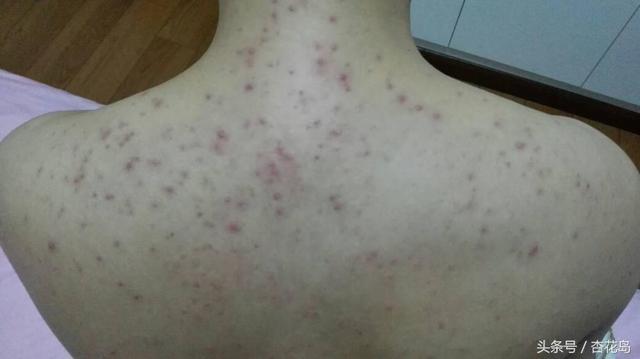
First of all, the diet should be light, it is advisable to eat more fruits and vegetables, avoid eating sweet, greasy, spicy stimulating things; second, to ensure that their routine, avoid staying up all night, to ensure that enough sleep; third, pay attention to as little as possible to use oily skincare products, to reduce the chances of clogging pores.
It is worth mentioning that whether it is acne or folliculitis, to treat the back out of the pimples, we can go to the supermarket to buy a piece of sulfur soap, shower with sulfur soap wash, not only can improve the blockage of the follicle mouth keratinization, but also kill the bacteria inside the pimples, which will make our skin back to normal. If the situation is more serious, it is recommended that we seek medical attention.
Answer: Zhang Qiqi, M.D.
Welcome to Apricot Island for more interesting health facts!
Pimples, commonly known as zits, tend to occur on the face, but can also occur on the chest and back. The causes of small pimples on the chest and back are the same as on the face, the oil glands on the chest and back are also very rich, together with lifestyle habits and other aspects, resulting in clogged pores and inflammation, which triggers pimples. There are often several reasons why small pimples grow on the forehead and back.
Poor hygiene habits, bathing does not pay attention to the back of the clean, clothes do not change, sheets do not wash, especially in the hot summer season, the body is more prone to sweating, coupled with the secretion of sebum, it is easy to mix in a piece of the formation of bacterial growth of the best venues, which in turn clogged pores triggered by inflammation and long acne.
Poor dietary habits, like to eat fried, spicy food, these foods tend to aggravate the sebaceous glands secretion more exuberant, triggering and aggravating the acne on the chest and back. Irregular life, stress, emotional anxiety, these will lead to the body's endocrine imbalance, triggering the occurrence of acne.
When small acne on the front and back, daily bathing is essential, pay more attention to the cleaning of all parts of the body, and regularly remove old keratin when necessary. Keep your diet light, eat more vegetables and fruits and other foods containing vitamins and dietary fiber, and eat less fried, spicy and other stimulating foods with lots of fat. Nurture a relaxed mood, ensure enough rest and avoid bad emotions.
Acne on the front and back has a lot to do with lifestyle habits, so it's important to develop good habits in order to address and prevent this problem from occurring.
Instructor: Hu Yunfeng, Associate Chief Physician, M.D., Deputy Director, Department of Dermatology, The First Affiliated Hospital of Jinan University.
Specialties: cosmetic skin laser, diagnosis and treatment of acne, chloasma and other disfiguring skin diseases, skin histopathology.
If you find this article useful, please feel free to like or recommend it to your friends and follow [Medlink Media].
In fact, the description of the subject is not very accurate, the chest and back of these seborrheic area of the "acne", it happens to be in puberty and young adults the most common, because this period of time to grow, androgen levels are higher than usual, and androgen for the sebaceous glands to promote the secretion of the left and right. Excessive sebum secretion can lead to overproliferation of some normal skin flora, which can lead to acne and folliculitis.
The reason why it's called 'normal flora' is because normal people also have these oleophilic bacteria, Acinetobacter and Furfura, on the surface of their skin, it's just that if you don't have oily skin, they can't get enough to eat and don't have the ability to mess things up for you. And when they overpopulate and cause skin disorders, it's impossible to pursue their complete eradication from the skin, it's unrealistic and unnecessary, you just need to maintain their numbers at a reasonably low level through some life care and medication.
Option 1: Sulfur Soap
The sulfur soap that has been pounded into the dusty nooks and crannies of supermarkets by trendy soaps and handmade soaps actually has its own wonderful uses that are most appropriate for this type of situation. Sulfur is only mildly antibacterial in low concentration topical washes, but its ability to inhibit sebum production is highly desirable. Since the oleophilic bacteria eat oil, we can use sulfur soap every 3 - 5 days to take a bath. But remember not too often, so as not to dry the skin too much and flaking.
Approach 2: Dietary modifications
High-sugar and high-fat diets can promote sebum secretion and are best avoided. Spicy diets also have an effect on this, while acids do not need to be avoided.
High-protein fish and shrimp and other food is the existence of allergies only need to avoid the people, acne and folliculitis do not need to avoid this.
If you are taking oral medication, it is best not to drink alcohol in order to avoid aggravating your liver.
Option 3: Topicalization!
Lifestyle treatments that start with just suppressing sebum are slow to work, and we actually have safe and effective medications available that don't need to wait for results at all:
Acinetobacter: Clindamycin phosphate gel, fusidic acid ointment, and other ointments are sensitive to most gram-positive bacteria including Acinetobacter. Erythromycin ointment, on the other hand, is not recommended because most are resistant.
Furfura: ketoconazole, miconazole, and bifonazole are effective, while terbinafine is less sensitive.
Helminth mites (follicular mites): Helminth mites, which are more commonly found on rosacea than on the front and back of the chest, can be killed by metronidazole gel.
Moreover, all of these drugs are very safe. Most of the topical medicines only work locally on the skin, and the amount that enters the bloodstream will not be more than 5%, which is very small, and such a small amount is evenly distributed to the four or five liters of blood in the whole body, which is basically impossible to cause any effect on the overall health. Moreover, these are not hormonal creams, so they can be used for a long period of time according to the needs of the condition.
In severe cases where nodules and cysts form, topical medications may not be as effective, and it is then necessary to visit a hospital and have the doctor prescribe medications at his or her discretion that are appropriate for the individual to control.
I have always believed that the most efficient way to solve problems is to leave professional things to professionals. If you listen to anecdotal evidence with no scientific basis, do not ask about the pathology, do not ask for evidence, to believe in some anatomical non-existent meridians, I'm afraid that only when you press to your old age, sebaceous glands do not secrete so much oil, the disease can only be cured by itself. And in the meantime people who have received regular treatment have been beautiful for decades.
Back pimples and acne are similar to facial pimples in that they are caused by active sebum secretion in that area and the accumulation of dead skin, which leads to inflammation and pimples. The oil glands on the back are very rich and the cuticle is thick, making it easy to clog pores. When the pores are clogged, acne will surely develop. You don't wash your hands and face as much as you should, so you're prone to acne, for the same reason you get acne on your face.
If you have acne on your back, it's best to pay attention to the following:
1. Daily bathing is essential, in addition to intensive deep cleansing, exfoliation, and then moisturizing. Wash gently as if you were taking care of the skin on your face so that you don't irritate your back acne too much, as over-washing can aggravate the inflammation of red, swollen acne.
2. Eat a light diet: eat more fresh fruits and vegetables, less fat, sugar and starchy food, less spicy and stimulating food, drink more boiled water to maintain good digestion.
3. High work pressure, poor mood, irregular life and lack of sleep are all triggering factors for acne. Keep a relaxed mood, pay attention to rest, ensure enough sleep, and keep a happy and optimistic mood.
4. Usually in clothing should also choose cotton fabrics, and sweat-absorbing clothing, be sure to avoid wearing non-breathable nylon material, try to keep the skin in a dry state, which will help to solve your back acne.
5. Use all kinds of cosmetics with caution, especially those with high oil content and powdered cosmetics, etc.
6. Do not scratch or squeeze the rash to avoid spreading the inflammation.
7. Those with more serious conditions and obvious inflammation should go to the hospital in time and use medication under the doctor's guidance in order to control the post-inflammatory hyperpigmentation or the formation of scars. (Duty Editor: Li Na)
In our chest and back also have distribution of sebaceous glands, when the endocrine changes and other factors, stimulate the body androgen secretion more, will stimulate the sebaceous glands to secrete more oil, as well as some of the factors inherent in our body, such as the function of the internal organs, can also lead to skin acne, coupled with the back itself, because although we have oil secretion, but it is usually in the cleaning time may also be cleaned. Not thorough enough, then it will also lead to acne.
So for acne to improve completely, you must go to the root to find this cause, and what, to solve the root cause.
1, it is recommended not to stay up late at night, try to be able to go to bed before 11:00, you can get up earlier in the morning to ensure sufficient sleep.
2, keep a good state of mind, do not be impatient, and when you have anger, you should eliminate it in time.
3, more exercise, exercise sweating can also help us promote the body's metabolism, which helps to improve acne.
4, diet must not eat spicy greasy stimulating food, and sugar very high food including sugar high fruit, sweets.
Also avoid alcohol and tobacco.
5, when you take a shower, you can choose a slightly stronger cleaning ability of the shower gel, can help clean more clean and thorough.
The reason for this is simple, it is the pores of the back, which secretes oils and clogs them, forming folliculitis.
Why is it clogged?
As an adult, there is a lot of oil production, and bathing is out of reach and rarely cleans the back thoroughly.
Why are there more men? Because men bathe quickly and rarely wash their backs, and women rub slowly.
It used to be a pool bath with a thorough soak and cheap scrubs.
Now it's all showers and very little back rubs.
How do I fix it?
Use salt water, soak in a bath, and then rub your backs, married couples rubbing each other, unmarried ones going to the bathhouse, or girlfriends, gay friends rubbing each other.
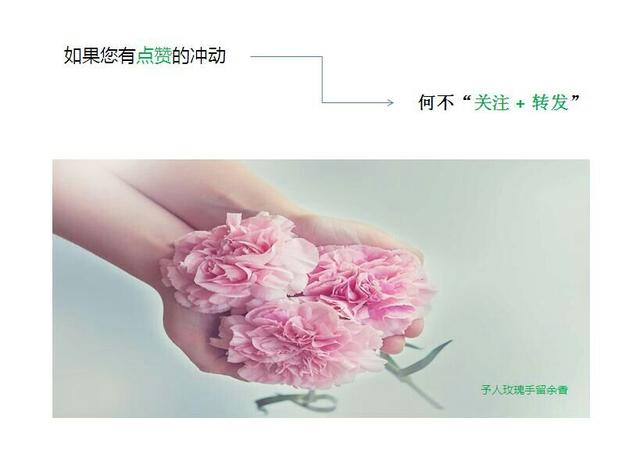
Thank you Master Goku for the invitation:
Most pimples on the back are acne, also known as pimples, and do not occur in intended teenagers.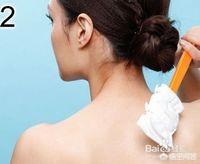
It is caused due to the clogging of the skin follicles, which is related to the high oil production in the hair follicles on the back. Symptoms include blackheads and pimples, nodules, abscesses, and cysts in various forms. It is an embolism caused by over-keratinization of the skin.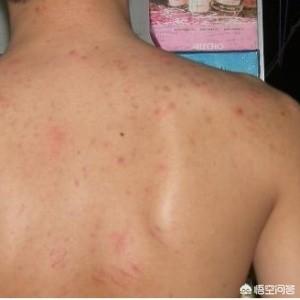
The cause of vesicles is the follicle sebaceous gland chronic inflammation caused by sebum excretion disorder. Is due to endocrine dysfunction in young people, looking for hormone secretion into, its choice and Xing abnormal inversion, not only secretion of too much montgomery mouth coking excessive period of flagging outflow is not good, resulting in easy to become a bacterial colony breeding and cause vesicular rash. But all of them hurt and do not itch.
There are also causes of pimples and beans, are allergies, to summer and then to summer in the sun after sun exposure, can also appear pimples, if it is an allergy, then there will be an itching sensation.
attention (heed)
Pay attention to the cleanliness of your body and clothing, bathe often, and change your clothes often Wear loose-fitting tops to prevent clothes from sticking to your back. Increase the growth of bacteria.
In terms of life, eat less greasy food, less spicy as well as stimulating food, less alcohol and less smoking, and eat more light and de-flaming food.
In addition to maintain a cheerful mind, encounter depressed things, are and friends to communicate, because depressed mood, will lead to the blockage of transportation, will cause the growth of acne.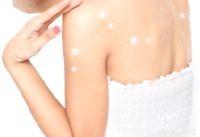
Thanks for inviting to answer the question ''Why do you get small bumps and pimples on your back''?
Hello friend! This question carries a generalization, and indeed, it is common to see patients with rashes and small bumps on the back in the clinic.
This symptom of the skin is medically called folliculitis, acne dermatitis. It is a symptom of exuberant sebaceous gland secretion, secondary infection, and a manifestation of heavy dampness in the body.
There is also a type of molluscum contagiosum, which is transmitted by a wart-like virus. It is elevated above the skin, has waxy vesicles, and often has scratches secondary to infection.
Treatment: "1" First of all, pay attention to the hygiene of the skin, take frequent baths to clean the skin, but avoid scrubbing! Squeeze the bumps to prevent inflammation from spreading.
2" usually eat more vegetables and fruits, enhance the skin resistance. It is advisable to eat a light diet, avoid hair and other oily, spicy food consumption. Eat more barley, oats, red beans and other staple foods, in addition to wet bath food.
"3" to eat clearing heat and detoxifying Chinese patent medicines, inflammation oral antibiotic clarithromycin or erythromycin tablets plus metronidazole oral treatment course of 7 a IO days.
4) Topical Bactrim ointment, green ointment, etc. can be used if there is an infection.
Molluscum contagiosum can be electrically removed, scraped, and sterilized with iodine.
My answer to the question will be helpful to those who need it, so stay tuned!
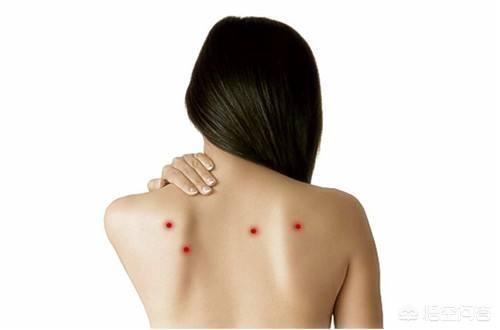
Back acne is a skin problem that plagues many people, including myself. From my personal experience, there are usually these reasons for back acne:
High oil secretion
The back has a lot of sebaceous glands, so it is more likely to produce a lot of oil compared to the face. If you don't get timely and spot-on cleaning, it can build up with old keratin and clog pores to form pimples.
hyperhidrosis
Some people love to sweat, and when the weather gets a little hotter, they sweat a lot. At this time, the back of the sweat due to wearing clothes failed to evaporate in time, and no conditions at any time to rinse, it will lead to bacterial growth and make acne pimples or even folliculitis appear.
Lack of change of personal clothing
This situation is common in winter, we wear loungewear, pajamas, thermal underwear, etc., sometimes lazy or forget to change and wash every day, and the skin friction contact more flakes and oil mixed together to trigger acne.
too dry
Some friends back acne will use the soap constantly wash, fall and winter seasons do not apply body milk. Over time, the back of the skin barrier is damaged, just like the face of the formation of "outside oil inside dry" state. At this time the skin is very fragile, the outside world a little stimulation is easy to cause infection, and then began to grow acne.
There are several things you can do to address back acne:
practice good personal hygiene
Take a shower every day, change your intimate clothes, and don't feel free to scratch your back with hands that have touched a lot of things outside. If you have the habit of sleeping naked, you have to be more diligent in changing your sheets and blankets.
body lotion
If the skin on your back is dry, it will be itchy, and in the process of scratching the skin, it is easy to scratch the skin to increase the chance of bacterial infection. So make it a habit to use body lotion to avoid acne on your back due to bacterial infection.
Seek medical help
If the acne on your back is never good, consider whether it is folliculitis. At this time, you should go to the dermatology department of a tertiary hospital to consult a doctor, and don't use products or medications on your own.
Apart from the face, front and chest, the back is indeed a popular site for acne, which manifests itself in the form of scattered blackheads, pimples, pustules, nodules and cysts.
The process of acne formation: dysfunction of internal organs → endocrine imbalance → sebaceous glands secrete excessively → excessive oil → pores are enlarged/clogged → the stratum corneum thickens and oil gradually rises towards the surface of the cortex → the stratum corneum rises, and the oil clogs the pores. The top of the bulge oxidizes and turns black → bacteria stir up with the oil in the pores → Propionibacterium acnes multiplies in the absence of oxygen → leading to the invasion of inflammatory bacteria, which turns into pustules and nodules → the entire hair follicle becomes red and inflamed → the bacteria spreads to the nearby skin tissues, which become larger, and acne is then formed.
The back provides the conditions for the development of acne. The back is the thickest part of the epidermis except the soles of the feet, and because of this, the circulation and metabolism of the back is weaker, and it is easier for fat and waste to accumulate and form acne. In addition, the back is often neglected because it produces a lot of oil and sweat and is not easy to clean. If you don't clean your back thoroughly for a long period of time, fat and waste will accumulate more easily, which will lead to inflammation and acne.
In addition to acne, Malassezia folliculitis may occur on the back. Pathogenic bacteria are Malassezia furfur or Malassezia globosa, Malassezia is a normal human parasite, under the influence of hair-promoting factors (such as long-term use of glucocorticosteroids or broad-spectrum antibiotics, etc.), Malassezia can be a large number of reproduction within the hair follicle, its lipolytic enzymes will be the follicle site of the decomposition of triglycerides into free fatty acids, the latter can be stimulated to the mouth of the follicle to produce a greater number of flaking and cause obstruction to the sebaceous retention, coupled with the free fatty acid Stimulation leads to follicular dilation and rupture, resulting in the release of follicular contents into the surrounding tissues, producing an inflammatory response. It occurs mostly in young and middle-aged people, especially in men. The lesions are inflammatory follicular papules, papules or small pustules, hemispherical in shape, 2-4 mm in diameter, surrounded by hongs, which can extrude a powdery fat-like substance. Dozens or even hundreds of them are distributed densely or scattered, as shown below. There are varying degrees of itching, aggravated by sweating. Patients often have excessive sweating and grease overflow.
References:
[1] Song Liping. Treatment and preventive measures of acne[J]. China Aesthetic Medicine,2010,(z3):64-64.
[2] Mai Bao Hong. Sexy back 3 steps[J]. Public Health,2012,(8):116-117.
[3] Zhang, X.J., ed. Dermatologic venereology (8th ed.). Beijing: People's Health Publishing House. p:89.
Follow the headline number of "medical catechism", more health Q&A easy to see!
This question and answer are from the site users, does not represent the position of the site, such as infringement, please contact the administrator to delete.